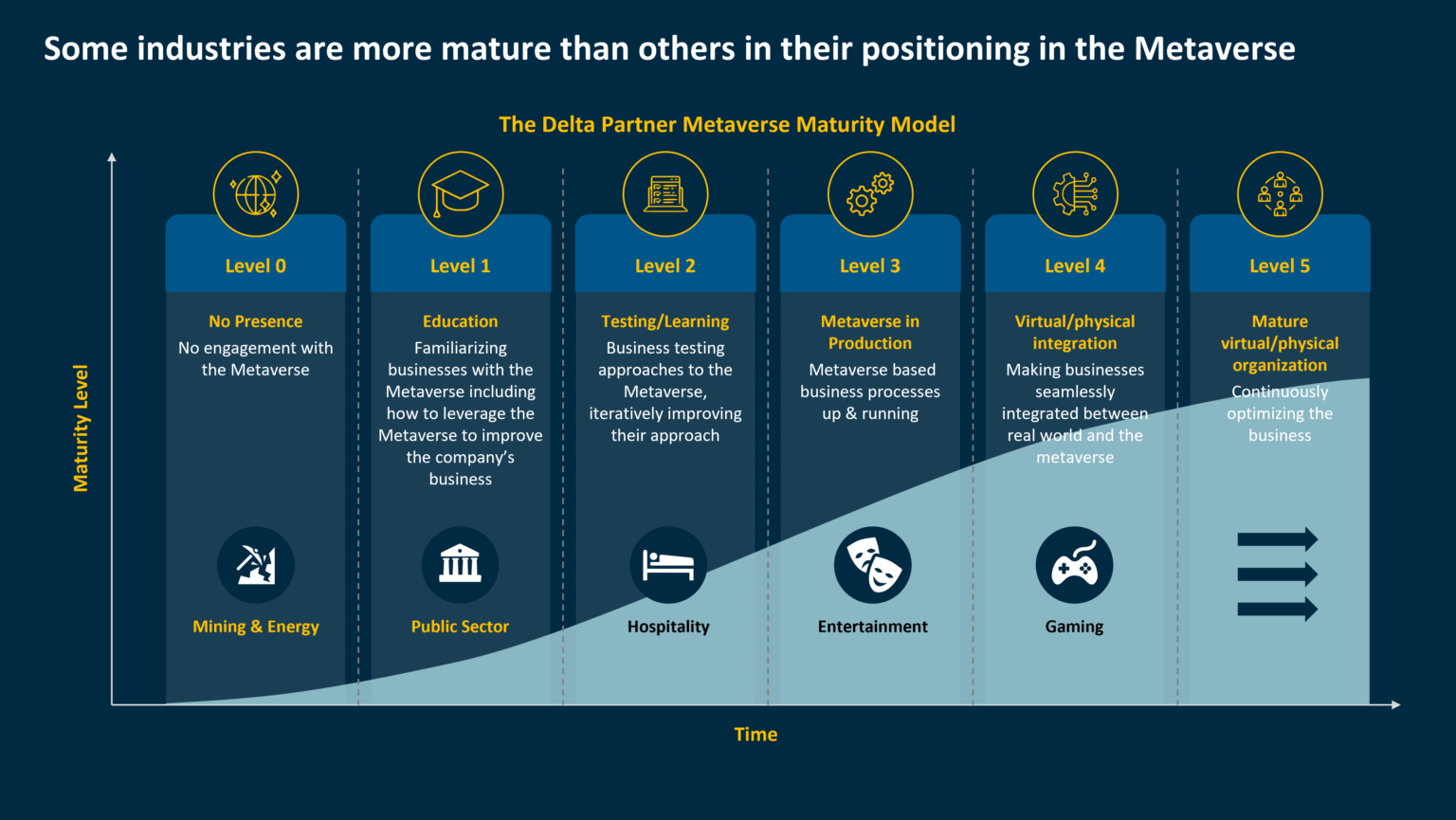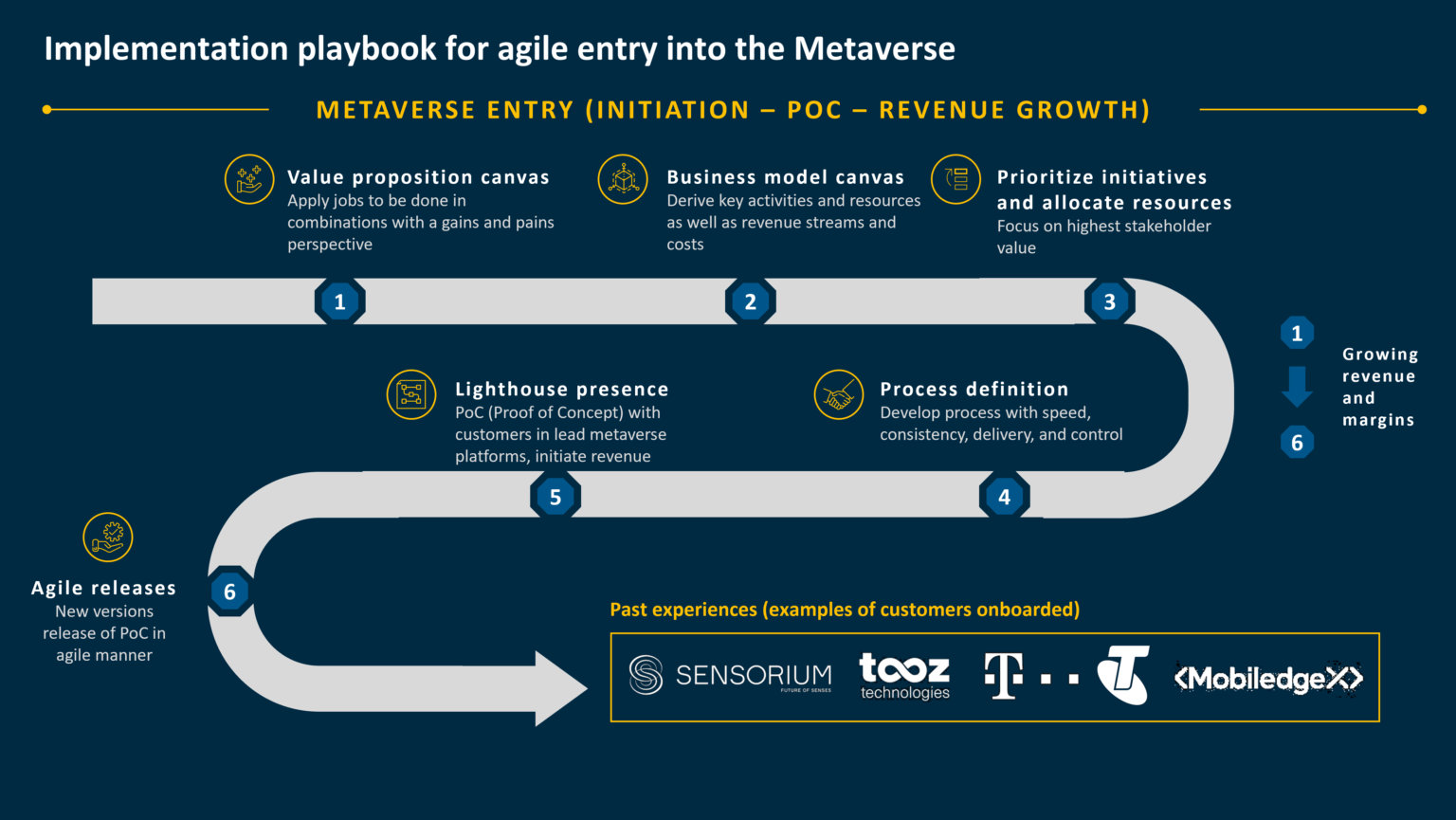Beyond the hype: The lasting effects of the metaverse wave
Beyond the hype: The lasting effects of the metaverse wave
The Metaverse revolution is not about virtual reality, enhanced gaming or NFTs: it is about a paradigm shift over the foundational economic factors. Your value chain will be turned upside down in this new reality through the technology foundations of web 3.0. Your business must be quick to adjust to the new reality if you want to make the most of it.
What is hype and what is not
The trending Metaverse subject is a hot topic worldwide, as you might already be aware. Gartner recently named it one of the top five emerging technologies and trends for 2022. The term “metaverse” was discussed by 40% more companies in their filing’s documents during the first quarter of 2022 vs end of 2021, according to GlobalData, often paired with other keywords such as “invest” and “clients”.
Looking beyond the hype, some raise the concern that the metaverse is nothing but that: a trending topic. Sceptics argue that metaverse is just “good marketing”, and that most of the technologies integrating the metaverse have either been around for years or are not yet developed. It is commonly agreed that there is not yet a fully-fledged metaverse, just companies rebranding pre-existing technologies.
Research and personal findings suggest that this is a narrow view, focused only on short-term impact. Beyond the evolution of existing technologies through Web 3.0, the metaverse should be perceived as a new socioeconomic paradigm, which expands the value chain and the economic factors we have today. The production of goods and services will be boosted through unlimited virtual land, new labour resources will be created with AI (Artificial Intelligence), and capital intermediation and ownership will shift. All of this will grow exponentially by leveraging the steady increase in computing power according to Moore’s law, which predicts that the number of components per integrated circuit doubles every two years (and therefore, so do their processing speed and capability).

The expansion of economic output
Across all business segments and industries, these improved capabilities allow the expansion of the economic outcome. Take this example, applied to the real state sector: unique personalized bundles that include fractional ownership of a hotel room for the Easter holidays in Aspen, together with a table at the Metropolitan Opera New Year’s Eve Gala and a guaranteed appointment with a renowned hair stylist booked for the previous day. Through the metaverse, this highly complex chain of events could be orchestrated with low transactional costs and maximized time efficiency.
The expanding range of products and production factors is observed across all three dimensions of the current capitalist model:
Land: Living and working environments have changed and extended into the digital world, where space is unlimited and mobility unrestricted. In theory, land is now far more available, making it much more available for economic expansion.
Labor: Available work is expanding through a global workforce connected to the same platform, including, but not limited to, remote physical labor by controlling a device or robot present on site. At the same time, non-creative tasks are increasingly outsourced to artificial intelligence entities. Assuming Moore’s law will continue to apply as a result of developments such as quantum computing, AI will multiply employment opportunities exponentially by creating new professional roles that we cannot yet imagine.
Capital:
Disintermediation through blockchain registry decreases the capacity for capital intermediaries (such as banks) to earn passive income over transaction fees. removing the intermediary between the provider and the customer, which expands the economic value of assets created, the ownership of the assets (objects/services) goes back to the provider with royalties that can be controlled with zero overhead.
Fractional ownership with NFTs simplifying shared ownership of physical and virtual assets, distributing the creation of assets with shared content, product, and services for physical and virtual objects. The closest can currently get are that large organizations retain ownership of their assets but allow small investors to buy shares.
Unlimited expansion of the universe means that capital is no longer a constraint. Everyone can create and customize their own little piece of the metaverse, just as everyone can have their own URL on the Internet. Moore’s law doubles the amount of compute resources per dollar every 2 years – resulting in the possibility of continuous expansion of the metaverse for a given annual financial investment. Quantum computing might technically double this exponential rate according to Neven’s law, named after Hartmut Neven, Director of Google’s Quantum Artificial Intelligence Lab.
Clean slate for new type of capital, and capital records, with opportunity to acquire assets in the Metaverse for a modest price, as the winning metaverse representation is not yet defined – the caveat is that currently large organizations are trying to monopolize the Metaverse and re-establish the existing connection between asset ownership and capital holdings.
As Aristotle once observed, what we consider capital is determined by convention, not by nature. Consequently, new forms of capital can be defined and will become valuable once accepted by a substantial part of the population. Good examples of this are Bitcoin and Ethereum, which created an entirely new kind of currency and drove an influx of wealth around the world.

Impact in different industries
Cognizant of this transformational reality, companies can make the most of the metaverse by moving beyond the current conversation surrounding the metaverse, centered on marketing/3D interactive experiences, and instead focusing on expansion of economic throughput.
Current metaverse-like platforms, used mostly by gamers and teenagers, should be seen as a first proof of concept, similarly to how the early Internet appealed chiefly to niche, tech-savvy users at the time. But in the metaverse’s second phase, companies will discover its business value, just as the Internet became a significantly impactful technology for brands.
Different industries have started to invest in metaverse initiatives and compete across each layer of the ecosystem. To cite a few examples, leading telecommunication players like Orange and SK Telecom are helping build the metaverse, mainly via connectivity infrastructure such as 5G networks and VR enablers. Gambling platforms are experimenting with the metaverse as well through NFTs and virtual casinos (which are proving to be a lucrative venture, with the ICE Poker casino in Decentraland making $7.5 million in revenue in just three months). Sports and entertainment brands have likewise jumped on the NFT bandwagon and are also investing in immersive customer experiences like broadcasting live virtual or hybrid events. Hospitality companies including Marriott, Four Seasons and IHG have begun to look to the metaverse for marketing and upselling opportunities such as immersive 3D tours of the facilities, hosting virtual and hybrid events, offering virtual itineraries, and blockchain-enabled contract management.
Business applications for the metaverse will happen across all industries and indications are already visible. Potential use cases increasing capabilities through expanded economic factors are observed, for example, in the gaming industry. It took them more than one decade to reach the current level of maturity, and transformed it into one of the most advanced sectors in terms of metaverse-related developments such as merging the physical and digital worlds, offering immersive environments, and taking user experience to the next level of engagement.
Although competition is getting tough in the metaverse race, there are still many entrepreneurial opportunities to be explored. For example, the hospitality sector can be elevated by offering unique personalized bundles through fractionally owning a hotel room for Christmas in Aspen combined with a table at the Metropolitan Opera Gala at New-Year’s Eve with guaranteed availability of viewing point on top of the Empire State Building to see the fireworks. This highly complex chain of events can be orchestrated with low transactional costs and high time efficiency.
The next question your brand needs to consider is where your industry lies in the maturity model, and what can be done to go one step further.

Venture into the metaverse with FTI Delta
If you can visualize potential opportunities in the metaverse, so can your competitors (and some of them have already started to realize them). At FTI Delta we have developed a three-step methodology to systematize and summarize the strategy and roadmap for every company to play a relevant role in the metaverse, which are:
Identify value levers for your organization by investigating growth production factors across products and services.
Assess the current and desired states for each value driver through the maturity model achieved by the organization.
Implement initiatives with a clear playbook that prioritizes deriving business value through an agile methodology.
A) Identify value levers: FTI Delta has developed and systematically deployed a method to identify the value creation levers for an organization, a framework for maturity assessment, and implementation guidelines to create revenue, margin, and stakeholder value for your brand. The first step to identify value levers for a company or government organization is based on the macroeconomic model, in which value is created by either growing production factors or expanding products and services.
Value can be derived through:
Substitution/combination: Consolidation of AI and human workforce to increase throughput. For instance, a shared labor pool in the metaverse can bridge the talent gap by bringing remote, skilled workers to all markets.
Elimination/magnification: Elimination of major bottlenecks in the value chain to expand output. For example, using no-code software to eliminate the need for a software engineering center.
Adaptation/modification: Enabling access to information and/or data to remove production barriers, e.g., authenticity as a service or sale of component blueprints.
B) Assess the current state and desired target state: Mapping the sources of value is the fundamental first step. After that, your organization should identify how developed each of these sources are. FTI Delta recommends that every company grows along our Metaverse Maturity Model framework, which allows you to understand how far ahead you are in your metaverse journey in terms, for example, of technologies or talent available. This assessment of the organization’s current maturity level will allow us to move to step 3 and draft a valuable blueprint for growth.
C) Implement/integrate your initiative within the Metaverse: In this sea of uncertainty but tremendous opportunities we recommend leveraging the experience of those already venturing in these new waters. At FTI Delta, we have seen many companies spotting the opportunities in the metaverse and structurally targeting them.
Now is the time for your company to plan the same journey. Why? First, customers value future-oriented companies, as they know their purchases will have long-term value. Second, you can establish yourself in your market segment and occupy strategic virtual land before your competitors move in your metaverse niche. Third, in these uncertain times, you can build a lasting value chain leveraging the capabilities of the metaverse.
Applying the FTI Delta Metaverse Implementation Playbook will lead your organization through a low-risk, safe and secure journey in this technology-enabled leap into the metaverse.

We invite you to connect with FTI Delta and know more about the expanding possibilities in the metaverse. Contact us at info@deltapartnersgroup.com or aab@deltapartnersgroup.com to reach out to the team directly.


